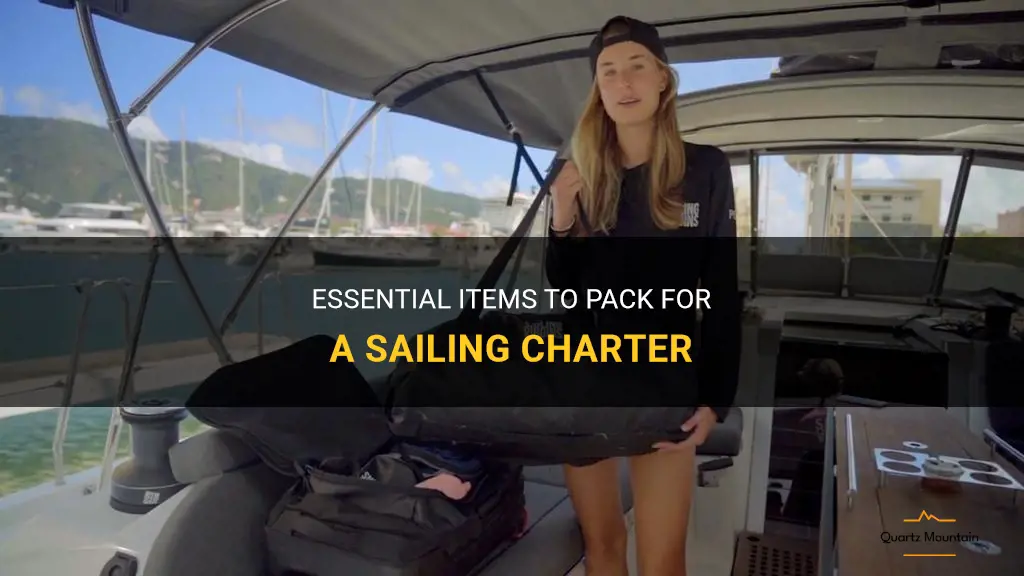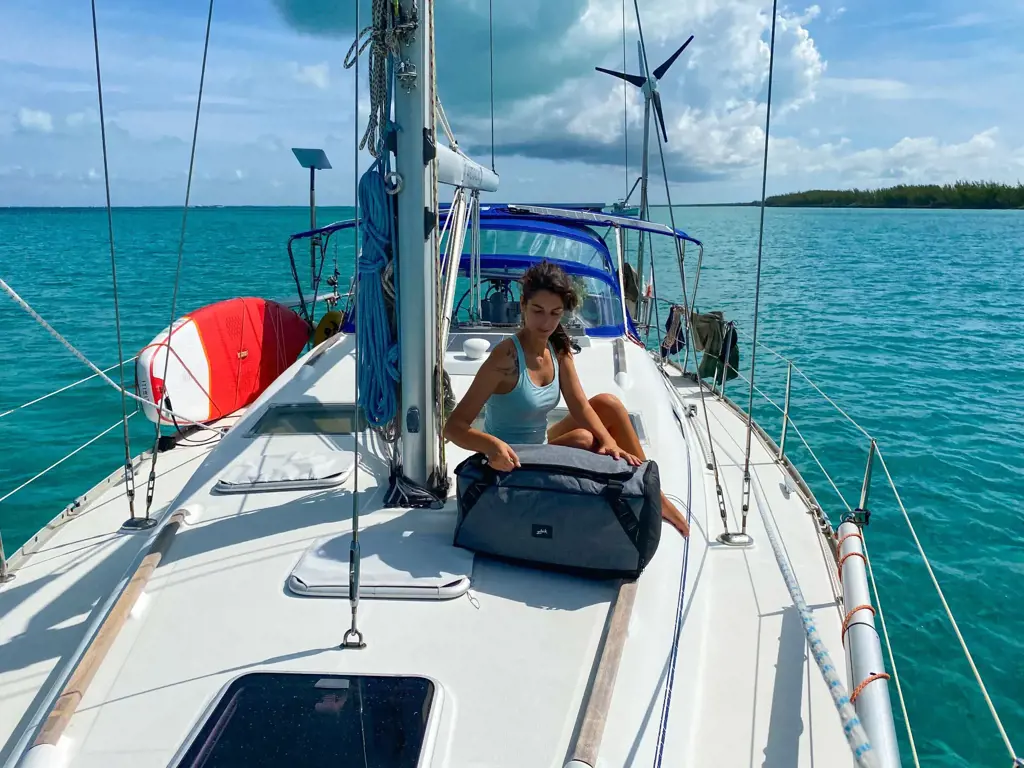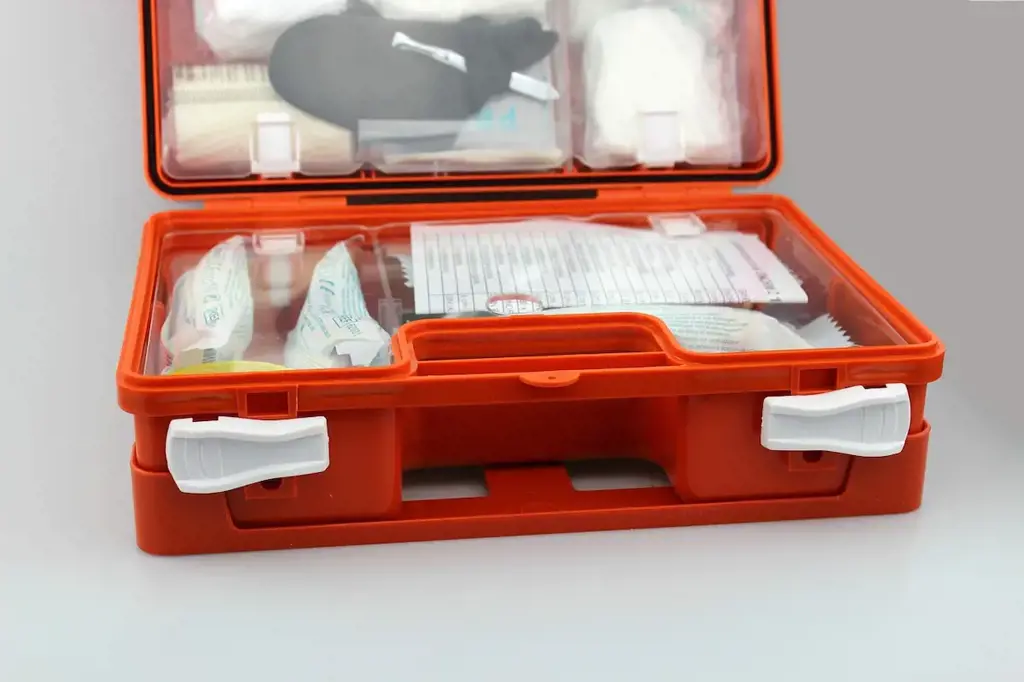
Heading out on a sailing charter can be an exciting and memorable adventure. Whether you're a seasoned sailor or new to the open seas, it's important to be prepared with the essential items to make your trip smooth and enjoyable. From safety equipment to personal items, packing the right gear can ensure a successful and stress-free sailing experience. So, before you set sail, let's take a look at the must-have items you should pack for a sailing charter.
| Characteristic | Value |
|---|---|
| Clothing | Lightweight, quick-drying clothing, swimsuits, cover-ups, hats |
| Footwear | Non-marking boat shoes, water shoes, flip-flops |
| Accessories | Sunglasses, sunscreen, insect repellent, waterproof phone case |
| Navigation equipment | Compass, charts, binoculars, GPS device |
| Safety equipment | Life jackets, first aid kit, emergency flares, fire extinguisher |
| Cooking supplies | Utensils, pots and pans, plates, cups, cooler |
| Food and drinks | Non-perishable snacks, canned foods, water, alcoholic beverages |
| Bedding | Pillows, sheets, blankets, sleeping bags |
| Entertainment | Books, games, snorkeling gear, fishing gear |
| Toiletries | Soap, shampoo, toothbrush, toothpaste, toilet paper |
| Miscellaneous | Cash, camera, binoculars, battery pack, dry bag |
What You'll Learn
- What clothing should I pack for a sailing charter?
- What personal items are essential to bring on a sailing charter?
- Are there any specific medications or first aid supplies I should pack for a sailing charter?
- What type of footwear is best for a sailing charter?
- Are there any specific documents or travel paperwork I need to bring on a sailing charter?

What clothing should I pack for a sailing charter?

When preparing for a sailing charter, it is important to pack the right clothing to ensure comfort, protection, and practicality. Whether you are going on a day trip or a longer voyage, here are some guidelines on what clothing to pack for a sailing charter.
- Layering is key: The weather conditions at sea can be unpredictable, so it is important to pack clothing that allows for easy layering. Start with a base layer made of moisture-wicking material such as merino wool or synthetic fabrics. This will help keep you dry and comfortable by wicking away sweat. On top of the base layer, pack a mid-layer such as a fleece or a light sweater to provide insulation. Finally, bring a waterproof and windproof outer layer, such as a sailing jacket, to protect you from the elements.
- Protect yourself from the sun: Spending long hours out at sea means exposure to the sun's harmful rays. To protect your skin, pack lightweight, long-sleeved shirts and trousers made of breathable and quick-drying fabric. Look for clothing with a high UPF rating to provide maximum sun protection. Don't forget to bring a wide-brimmed hat, sunglasses with UV protection, and sunscreen with a high SPF.
- Pack appropriate footwear: The right footwear is crucial for a sailing charter. Opt for deck shoes or sailing boots with non-marking soles. These shoes provide good traction and grip on slippery surfaces. It is also a good idea to pack a pair of light, quick-drying sandals for when you are on land or at the beach.
- Don't forget the swimwear: If you plan to swim or snorkel during your sailing charter, pack swimwear that is comfortable and suitable for active movement. A rash guard or a full-body swimsuit can provide extra sun protection while in the water. Also, bring a lightweight towel that dries quickly.
- Bring the right accessories: In addition to clothing, there are a few accessories that are essential for a sailing charter. A waterproof dry bag is handy for keeping your valuables safe and dry. A windproof and waterproof hat can provide extra protection during windy or rainy conditions. A pair of gloves can be useful for handling ropes and other sailing equipment.
Remember, each sailing charter is unique, so consider the specific weather conditions, duration of your trip, and any planned activities when packing your clothing. It is always better to pack a few extra layers and be prepared for any changes in weather. By following these guidelines, you will be well-prepared and comfortable for your sailing charter.
Essential Items to Pack for a Trip to the Canary Islands
You may want to see also

What personal items are essential to bring on a sailing charter?

When embarking on a sailing charter, it is important to bring along certain personal items to ensure a comfortable and enjoyable experience on board. Whether you are a seasoned sailor or a first-timer, these essentials will come in handy during your trip. Here are some personal items that are essential to bring on a sailing charter:
- Clothing: Pack clothes suitable for the weather conditions you will encounter during your sailing charter. Bring swimwear, t-shirts, shorts, light pants, a sweatshirt or light jacket, and a hat to protect yourself from the sun. Don't forget to pack a pair of sturdy, non-slip shoes for the boat and flip-flops for exploring the beaches.
- Sun protection: The sun can be fierce out on the water, so it is crucial to bring sun protection items. Pack sunscreen with a high SPF, sunglasses to protect your eyes from the glare, and a wide-brimmed hat to shield your face from the sun's rays. It is also advisable to bring a long-sleeved shirt or a rash guard for added sun protection.
- Toiletries: While most charters provide basic toiletries, it is always a good idea to bring your own. Pack items such as toothbrush, toothpaste, soap, shampoo, conditioner, and any other personal hygiene products you might need. Remember to bring a towel as well.
- Medications: If you take any prescription medications, make sure to bring enough for the duration of your sailing charter. It is also a good idea to pack a basic first aid kit with items like band-aids, antiseptic ointment, pain relievers, and seasickness medication, especially if you are prone to motion sickness.
- Electronics and entertainment: While sailing is a great opportunity to disconnect from the digital world, it is still important to bring some electronics and entertainment items. Pack your smartphone with a waterproof case, a portable charger, a camera to capture your sailing adventures, and any other electronic gadgets you deem essential. You may also want to bring books, magazines, playing cards, or board games to keep you entertained during downtime.
- Personal items: Don't forget to pack your personal items such as identification documents (passport, driver's license), money, credit cards, and any necessary travel documents. It is also a good idea to bring a waterproof bag or container to keep these items dry and secure.
- Snorkeling gear: Many sailing charters offer the opportunity to go snorkeling, so it is worth bringing your own snorkeling gear if you have it. This includes a mask, snorkel, and fins. However, if you don't have your own, most charters provide snorkeling equipment.
- Reusable water bottle: Staying hydrated is crucial when sailing, so be sure to bring a reusable water bottle. This will not only help you reduce single-use plastic waste but also keep you hydrated throughout the day.
In conclusion, when preparing for a sailing charter, it is important to pack the right personal items to ensure a comfortable and enjoyable experience. Clothing suitable for the weather, sun protection items, toiletries, medications, electronics, personal items, snorkeling gear (if available), and a reusable water bottle are all essential items to bring on board. By having these essentials on hand, you will be well-prepared for your sailing adventure.
Tips for Packing to Move Overseas: A Comprehensive Guide
You may want to see also

Are there any specific medications or first aid supplies I should pack for a sailing charter?

When planning a sailing charter, it's important to be prepared for any unexpected situations or emergencies that may arise. This includes packing the necessary medications and first aid supplies to ensure the safety and well-being of everyone on board. Here are some recommendations for what to include in your sailing charter first aid kit:
- Seasickness medication: Seasickness is a common issue that many people experience while out at sea. It's important to have medication on hand to help alleviate symptoms such as nausea and dizziness. There are several over-the-counter options available, such as Dramamine or Bonine, which can be effective in preventing or reducing seasickness.
- Pain relief medication: In the event of any injuries or discomfort, it's essential to have pain relief medication readily available. Ibuprofen or acetaminophen can be used to alleviate minor aches and pains, such as headaches or muscle soreness.
- Motion sickness wristbands: In addition to medication, motion sickness wristbands can also be helpful in reducing symptoms of motion sickness. These bands work by applying pressure to acupressure points on the wrist, and they can be an effective alternative or complement to medication.
- Antiseptic solution: It's important to have an antiseptic solution, such as hydrogen peroxide or rubbing alcohol, on hand for cleaning and disinfecting any minor wounds or cuts that may occur while onboard. This will help prevent infection and promote proper healing.
- Bandages and adhesive tape: These are essential supplies for covering and protecting any wounds or cuts. It's recommended to have a variety of sizes and types of bandages, including adhesive bandages, gauze pads, and adhesive tape, to accommodate different types and sizes of injuries.
- Sterile saline solution: If someone onboard gets something in their eyes, having sterile saline solution can help flush out any foreign objects and provide relief. This can be especially useful if there is limited access to fresh water.
- Antihistamines: Allergies can flare up at any time, so it's important to have antihistamine medication available. This can help alleviate symptoms such as itching, swelling, and runny nose due to allergic reactions or insect bites.
- Sunburn relief: Spending long hours out in the sun can lead to sunburns. Packing aloe vera gel or a sunburn relief spray can help provide soothing relief for sunburned skin.
- Emergency contact information: Make sure to have a list of emergency contact numbers, including local emergency services and the nearest medical facilities. This information should be easily accessible for everyone onboard.
- First aid manual or guide: It's always a good idea to have a first aid manual or guide on hand in case you need to reference how to treat a specific injury or condition. This can be a valuable resource, especially if you are in an area without access to immediate medical assistance.
Remember, first aid supplies should be stored in a waterproof container and kept in a location that is easily accessible to everyone onboard. It's also important to periodically check the expiration dates of medications and replace any expired items.
By packing these essential medications and first aid supplies, you can help ensure the safety and well-being of everyone onboard during your sailing charter. Although it's always best to prevent injuries or emergencies, being prepared will give you peace of mind and allow you to enjoy your charter experience to the fullest.
Essential Items to Pack for a Memorable Danube River Cruise
You may want to see also

What type of footwear is best for a sailing charter?

When going on a sailing charter, it is important to wear the appropriate footwear to ensure a safe and comfortable experience. The right type of footwear can help you maintain your balance on the boat, protect your feet from potential hazards, and provide the necessary grip on wet surfaces. Here are some important factors to consider when choosing footwear for a sailing charter:
- Non-Slip Soles: The most important feature to look for in sailing footwear is a non-slip sole. On a boat, the deck can become slippery due to water, salt, or other factors. A non-slip sole will provide the necessary traction to help you maintain your footing and prevent accidents. Opt for shoes with rubber or synthetic soles that are specifically designed for traction on wet surfaces.
- Closed-Toe Design: To protect your feet from potential injuries, it is advisable to wear closed-toe shoes on a sailing charter. There is a risk of stubbing your toes, dropping heavy gear on your feet, or stepping on sharp objects while on board. Closed-toe shoes will offer the necessary protection and reduce the risk of foot injuries.
- Quick-Drying Material: Since you will be in close proximity to water, it is important to choose footwear made from quick-drying materials. This will prevent your shoes from becoming waterlogged and uncomfortable throughout the trip. Look for shoes made from materials such as mesh, neoprene, or synthetic fabrics that dry quickly and allow water to drain easily.
- Comfort and Support: Spending long hours on a boat can be tiring, so it is essential to choose footwear that is comfortable and provides adequate support. Look for shoes with cushioning, arch support, and a secure fit that will prevent your feet from sliding around or getting fatigued. The right footwear will allow you to enjoy your sailing charter without any discomfort or pain.
- Grip and Stability: In addition to having non-slip soles, it is important to choose footwear that offers good grip and stability. This is especially crucial when moving around the deck or climbing up and down ladders. Look for shoes with features such as grooves or patterns on the sole that enhance grip and provide stability on uneven surfaces.
Examples of suitable footwear for a sailing charter include deck shoes, sailing boots, or water shoes. Deck shoes are a popular choice as they are specifically designed for sailing and offer excellent grip, support, and protection. Sailing boots are another option, especially in colder climates or rough weather conditions, as they provide additional warmth and weather protection. Water shoes are a versatile option for warmer climates or if you plan on engaging in water activities such as snorkeling or swimming.
In conclusion, choosing the right footwear for a sailing charter is essential for a safe and enjoyable experience. Look for non-slip soles, closed-toe designs, quick-drying materials, comfort and support features, as well as grip and stability. By selecting appropriate footwear, you can ensure that your feet are protected and comfortable throughout your sailing adventure.
Essential Items to Pack for an Unforgettable Camping Experience
You may want to see also

Are there any specific documents or travel paperwork I need to bring on a sailing charter?

When embarking on a sailing charter, it is important to ensure that you have all the necessary documents and travel paperwork ready. This will help to avoid any unnecessary hassles or delays during your trip. Here are some of the documents and paperwork you may need:
- Passport or ID: Just like any other international travel, you will need a valid passport for sailing charters that involve crossing borders. Make sure your passport is valid for at least six months beyond your planned trip duration. If you are sailing within your own country, a government-issued ID may be sufficient. It is always a good idea to carry a photocopy or digital scan of your passport or ID as a backup.
- Visa: Depending on your destination, you may require a visa to enter certain countries. Research the visa requirements well in advance and apply for a visa if necessary. Some countries offer visa-on-arrival, while others require you to obtain a visa before arrival.
- Sailing License: If you plan to be the skipper or operate the sailing vessel yourself, you may need a valid sailing license or certification. The requirements for sailing licenses vary from country to country, so ensure that you have the appropriate qualifications and licenses for the region you plan to sail in.
- Crew List: If you are sailing with a group of friends or family, it is important to have an updated crew list. This includes the names, passport or ID numbers, and emergency contact information of all the individuals on board. Some countries may require you to submit this information in advance, so it is advisable to have it ready beforehand.
- Travel Insurance: It is highly recommended to have travel insurance that covers sailing charters, especially if you are traveling to remote locations or engaging in adventurous activities. Ensure that your travel insurance includes medical coverage, trip cancellation/interruption, and emergency evacuations. Read the policy terms and conditions carefully to understand what is covered and what is not.
- Boat Rental Agreement: If you are renting a sailing vessel, you will need to sign a boat rental agreement with the charter company. This agreement outlines the terms and conditions of the rental, including the duration, insurance coverage, responsibilities of both parties, and any additional fees or charges. Read the agreement thoroughly before signing and keep a copy for your records.
- Navigation Charts and Guides: Depending on the complexity of your sailing route, you may need navigation charts and guides. These provide detailed information about the waters, landmarks, buoys, and potential hazards. They are essential for safe navigation and planning your itinerary.
- Other Relevant Documents: Depending on the specific requirements of your sailing charter, you may need additional documents such as proof of boat ownership, proof of insurance coverage, diving certifications if you plan to scuba dive, fishing permits if you plan to fish, and radio licenses for operating a VHF radio.
Remember to check with your charter company or local authorities for any specific documentation or paperwork required for your sailing charter. It is always better to be well-prepared and have all the necessary documents in order to ensure a smooth and enjoyable sailing experience.
The Essential Food Guide for Hiking the Grand Canyon
You may want to see also
Frequently asked questions
When packing for a sailing charter, it's important to consider the weather and activities you'll be participating in. Some essentials to pack include sunscreen, a hat, sunglasses, and lightweight, breathable clothing. It's also a good idea to bring a swimsuit, towel, and water shoes for swimming and water activities. Additionally, packing a waterproof jacket and pants, as well as layers for cooler weather, is wise in case of sudden weather changes. Don't forget to pack any necessary medications, toiletries, and personal items.
Yes, there are a few specific items you'll need for the boat. It's important to bring non-marking, comfortable footwear with good grip for walking around on the deck. Deck shoes or boat shoes are ideal for this. You may also want to bring a small waterproof bag or dry bag to protect your personal items from water exposure. Additionally, packing a headlamp or flashlight with extra batteries is a good idea in case of nighttime emergencies or power outages.
When it comes to luggage for a sailing charter, it's best to use soft-sided bags or duffel bags instead of hard suitcases. Soft-sided bags are easier to stow away in the limited storage space available on a boat, and they can be compressed and maneuvered more easily. Hard suitcases can be bulky and take up valuable space. It's also a good idea to pack a smaller day bag or backpack for exploring on land.
While it's important to pack all the necessary items for a sailing charter, there are a few things you should leave at home. Avoid packing any valuables that you wouldn't want to risk losing or damaging, as boats can be a bit unpredictable and things can get wet. It's also best to leave any bulky items or excess luggage at home, as storage space is limited on a boat. Stick to the essentials and minimize the amount of stuff you bring on board.
If you enjoy snorkeling, it's a good idea to bring your own snorkeling gear for a sailing charter. While some boats may provide snorkeling gear, it's not always guaranteed and the quality may vary. By bringing your own gear, you can ensure a proper fit, comfort, and cleanliness. Plus, having your own gear means you can snorkel whenever you want, without having to rely on availability or rentals.







